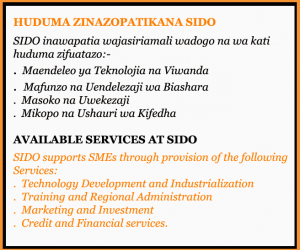1 INTRODUCTION
Small Industries Development Organisation (SIDO) is a parastatal organisation established in order to spearhead Small and Medium Enterprises (SMEs) development in mainland Tanzania. In order to promote SME development efficiently and effectively, SIDO has adopted a cluster development approach since 2006. Based on past success and further development potential, SIDO intends to strengthen cluster development approach during the period 2016/17 – 2020/21.
Under the above framework, the baseline data collection survey was designed to reveal the existing cluster SMEs’ current economic and social situation which would provide insight to developing policy options and support contents as well as provide basis for measuring effectiveness of the interventions. Dr. Vedastus Lyaya Timothy from the Institute of Rural Development Planning was contracted to conduct the baseline data collection survey.
2 TECHNICAL APPROACH AND METHODOLOGY
2.1 Overall baseline data collection survey design and methodology
The methodology that was adopted in undertaking the survey is structured interview using a detailed questionnaire developed by SIDO. The questionnaire was designed to collect business-related data from the enterprises which constitute the industrial cluster.
2.2 Survey site
The target area of this baseline data collection survey was theSIDO Karakana Cluster in Bilele Ward, Bukoba Municipality. The data was collected from 92 owner managers randomly selected in coordination with SIDO, the JICA Expert and the Association’s leadership. The survey was carried out using an enterprise questionnairestructured into nine sections as follows: general information, enterprise description, education and experience of the owner/manager, output and sales, industrial employment and labour costs, fixed assets, purchases made during reference period, competition and collaboration, business practices and other enterprise information as shown in Annex 1.
2.3 Data registration, processing and analysis
Responses were collected on tablet PCs using iSurvey® mobile survey software (HarvestYourData) and the database exported into spreadsheet format after ensuring wholesomeness and accuracy of the data.
Quantitative data was processed, analysed and organised in tables using IBM SPSS Statistics® 20 and Microsoft Excel®. Descriptive statistical values including frequency counts, percentage, min value, max value and average were calculated in order to explain distribution and general characteristics of the cluster. Qualitative information was used to provide in-depth description of the analysis and to complement the quantitative data.
2.4 Survey team and organisation
The survey was conducted by a team composed of one (1) consultant and five (7) enumerators. The Consultant facilitated thetraining of the enumerators and supervised the data collection at the cluster by enumerators through monitoring and data verification.
3 CHARACTERISTICS OF THE RESPONDENTS
This section present characteristics of household respondents in terms of age, sex of the household head, income source and household labour force.
3.1 General characteristics of the respondents
The number of respondents was 72, of which 38 percent were male and 62 percent were female, and most (58%) of them were the heads of the household. All respondents were between 23 and 81 years. that majority of the household respondents were in the age range of 50 < 65 years old which occupied 38percent of the people interviewed. Most of the remainder ware aged from35 < 50 years old, accounting for 36.1 percent of the respondents. Less than 10 percent of the household respondents were younger than 35 years old. The average age of respondents in the area was 51 years.All the operators use a common registration, business licence and TIN in the name of Tumejiajiri Karakana ya Viwanda Vidogo.
Table 1. General characteristics of the respondents
Frequency Percent
Sex of the owner/manager
Male 88 95.7
Female 4 4.5
Respondents’ age range
< 20 4 4.3
20 < 35 47 51.1
35 < 50 24 26.1
50 < 65 16 17.4
≥ 65 1 1.1
Number of enterprises owned/occupied
1 90 97.8
2 1 1.1
3 1 1.1
Registration with BRELA 0 0
Business License (common business licence for all operators)
TFDA 0 0
TBS 0 0
Type of legal organisation – Informal 92 100
Percentage of foreign ownership – none 92 100
Highest level of education of the owner/manager
No formal education 1 1.1
Some primary education 0 0.0
Completed primary education 55 59.8
Training after primary education 13 14.1
Some secondary education 3 3.3
Completed secondary education 8 8.7
Training after secondary 12 13.0
University 0 0.0
Years of formal education
Business experience of family
Respondents who are head of household
Initial capital borrowed from:
Bank 3 3.3
relatives 4 4.3
Friends 1 1.1
Customers 3 3.3
Own a bank account 21 22.8
CRDB 7 7.6
NBC 1 1.1
NMB 13 14.1
SEDA 1 1.1
Business experience of parents
Father owned business 9 9.8
Mother owned business 2 2.2
Average number of years in operation was 10.4 years, with maximum of 38 years. Initial capital ranged from TZS 5,000 to TZS 7,500,000 with an average of TZS 768,000. Average initial capital loan was TZS 550,000. On average, owners had 8.5 years of formal education. For details see Table 2.
Table 2. Number of years in operation
N Minimum Maximum Mean Std. Deviation
Number of years the enterprise has been in in operation 88 0.0 38.0 10.4 9.3
Initial capital amount (TZS) 68 5,000 7,500,000 768,000.0 1,410,533.6
Initial capital loan (TZS) 9 100,000 2,000,000 550,000.0 566,789.2
Years of formal education 91 7 14 8.5 2.2
3.2 Principal activities and products
Most respondents (50.0%) were in carpentry, followed by carpentry (20.7%) and mechanics (10.9%). Other sectors represented less than 5% individually, as shown in Table 3.
Table 3. Principal activities
Frequency Percent
Principal activities of the enterprise
Welding 46 50.0
Carpentry 19 20.7
Mechanics 10 10.9
Tailoring 3 3.3
Rubber stamp making 3 3.3
Metal fabrication 2 2.2
Key making 3 3.3
Other 6 6.5
A wide rang products is produced by the cluster as shown in Table 4
Table 4. Principal activities and products
Activity Products manufactured
Metal fabrication Steel cabinet
Water storage tank stand
Charcoal stove
Cooking pot
Rice mill
Steel gates
Steel doors
Steel chair
Steel bed
Vehicle frame (ngao)
Vehicle carrier
Window grill
Door grill
Wood works Chairs
Tables
Desks
Cupboards
Wood tables
Window tops
Door tops
Bed
Tailoring Shirts
Trousers
Skirts
Gowns
Seat cushion
Repair services Door locks repair
Key making
injector pump repair
Sewing machine repair
Car repair
Brick making Bricks
Seat covers Car seat covers
Motor cycle seat covers
Sign writing Sign board
Electrical services Solar system maintenance
Inventor maintenance
Rubber stamp making Rubber stamp


